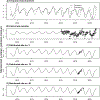A Spatiotemporal Prediction Model for Black Carbon in the Denver Metropolitan Area, 2009-2020
- PMID: 33596061
- PMCID: PMC8313050
- DOI: 10.1021/acs.est.0c06451
A Spatiotemporal Prediction Model for Black Carbon in the Denver Metropolitan Area, 2009-2020
Abstract
Studies on health effects of air pollution from local sources require exposure assessments that capture spatial and temporal trends. To facilitate intraurban studies in Denver, Colorado, we developed a spatiotemporal prediction model for black carbon (BC). To inform our model, we collected more than 700 weekly BC samples using personal air samplers from 2018 to 2020. The model incorporated spatial and spatiotemporal predictors and smoothed time trends to generate point-level weekly predictions of BC concentrations for the years 2009-2020. Our results indicate that our model reliably predicted weekly BC concentrations across the region during the year in which we collected data. We achieved a 10-fold cross-validation R2 of 0.83 and a root-mean-square error of 0.15 μg/m3 for weekly BC concentrations predicted at our sampling locations. Predicted concentrations displayed expected temporal trends, with the highest concentrations predicted during winter months. Thus, our prediction model improves on typical land use regression models that generally only capture spatial gradients. However, our model is limited by a lack of long-term BC monitoring data for full validation of historical predictions. BC predictions from the weekly spatiotemporal model will be used in traffic-related air pollution exposure-disease associations more precisely than previous models for the region have allowed.
Conflict of interest statement
The authors declare no competing financial interest.
Figures






Similar articles
-
Evaluating heterogeneity in indoor and outdoor air pollution using land-use regression and constrained factor analysis.Res Rep Health Eff Inst. 2010 Dec;(152):5-80; discussion 81-91. Res Rep Health Eff Inst. 2010. PMID: 21409949
-
Spatial Patterns in Rush-Hour vs. Work-Week Diesel-Related Pollution across a Downtown Core.Int J Environ Res Public Health. 2018 Sep 10;15(9):1968. doi: 10.3390/ijerph15091968. Int J Environ Res Public Health. 2018. PMID: 30201856 Free PMC article.
-
Development of season-dependent land use regression models to estimate BC and PM1 exposure.Sci Total Environ. 2021 Nov 1;793:148540. doi: 10.1016/j.scitotenv.2021.148540. Epub 2021 Jun 19. Sci Total Environ. 2021. PMID: 34171802
-
A unified spatiotemporal modeling approach for predicting concentrations of multiple air pollutants in the multi-ethnic study of atherosclerosis and air pollution.Environ Health Perspect. 2015 Apr;123(4):301-9. doi: 10.1289/ehp.1408145. Epub 2014 Nov 14. Environ Health Perspect. 2015. PMID: 25398188 Free PMC article.
-
Personal and ambient exposures to air toxics in Camden, New Jersey.Res Rep Health Eff Inst. 2011 Aug;(160):3-127; discussion 129-51. Res Rep Health Eff Inst. 2011. PMID: 22097188
Cited by
-
Application of artificial intelligence in quantifying lung deposition dose of black carbon in people with exposure to ambient combustion particles.J Expo Sci Environ Epidemiol. 2024 May;34(3):529-537. doi: 10.1038/s41370-023-00607-0. Epub 2023 Oct 17. J Expo Sci Environ Epidemiol. 2024. PMID: 37848612 Free PMC article.
-
Using non-parametric Bayes shrinkage to assess relationships between multiple environmental and social stressors and neonatal size and body composition in the Healthy Start cohort.Environ Health. 2022 Nov 19;21(1):111. doi: 10.1186/s12940-022-00934-z. Environ Health. 2022. PMID: 36401268 Free PMC article.
-
Prenatal black carbon exposure and DNA methylation in umbilical cord blood.Int J Hyg Environ Health. 2025 Jan;263:114464. doi: 10.1016/j.ijheh.2024.114464. Epub 2024 Sep 26. Int J Hyg Environ Health. 2025. PMID: 39332350
-
Early-life exposure to residential black carbon and childhood cardiometabolic health.Environ Res. 2023 Dec 15;239(Pt 2):117285. doi: 10.1016/j.envres.2023.117285. Epub 2023 Oct 11. Environ Res. 2023. PMID: 37832765 Free PMC article.
-
Adverse Effects of Prenatal Exposure to Oxidized Black Carbon Particles on the Reproductive System of Male Mice.Toxics. 2023 Jun 25;11(7):556. doi: 10.3390/toxics11070556. Toxics. 2023. PMID: 37505521 Free PMC article.
References
-
- US Environmental Protection Agency The Benefits and Costs of the Clean Air Act from 1990 to 2020: US EPA: Washington, DC, 2011.
-
- Kim K-H; Kabir E; Kabir S A Review on the Human Health Impact of Airborne Particulate Matter. Environ. Int 2015, 74, 136–143. - PubMed
-
- Feng S; Gao D; Liao F; Zhou F; Wang X The Health Effects of Ambient PM2.5 and Potential Mechanisms. Ecotoxicol. Environ. Saf 2016, 128, 67–74. - PubMed
-
- US Environmental Protection Agency Integrated Science Assessment (ISA) for Particulate Matter (Final Report, 2019); EPA/600/R-19/118; U.S. Environmental Protection Agency: WAshington, DC, 2019. - PubMed
Publication types
MeSH terms
Substances
Grants and funding
LinkOut - more resources
Full Text Sources
Other Literature Sources
Medical

